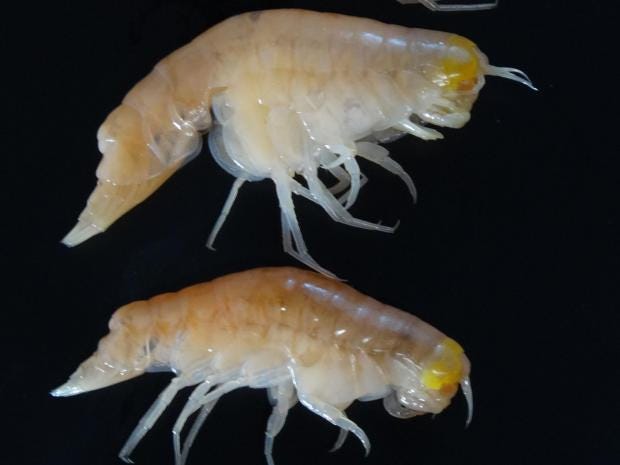
“Extraordinary” amounts of toxic chemicals that were banned in the 1970s have been discovered in the bodies of sea creatures living at the bottom of the deepest ocean trench in the world.
Scientists were stunned to discover that such high levels of polychlorinated biphenyls (PCBs) and other persistent organic pollutants were to be found more than 10km (six miles) below sea level in the Mariana Trench in the Pacific Ocean. It is about 1,300km from the nearest major land mass, Japan.
And a similar situation was found about 7,000km away in the Kermadec trench, which is also more than 10km deep and about 1,500km north of New Zealand, the researchers reported in the journal Nature Ecology and Evolution.
Dr Alan Jamieson, who led the study, said: “The fact that we found such extraordinary levels of these pollutants in one of the most remote and inaccessible habitats on earth really brings home the long term, devastating impact that mankind is having on the planet. It’s not a great legacy that we’re leaving behind.
“We still think of the deep ocean as being this remote and pristine realm, safe from human impact, but our research shows that, sadly, this could not be further from the truth.”
The pollutants were so widespread that the sea creatures, amphipods, had levels of contamination similar to those found in Suruga Bay, Japan, which Dr Jamieson described as “one of the most polluted industrial zones of the north-west Pacific”.
“We’re very good at taking an ‘out of sight, out of mind’ approach when it comes to the deep ocean but we can’t afford to be complacent,” he added. “This research shows that far from being remote the deep ocean is highly connected to the surface waters and this means that what we dump at the bottom of the sea will one day come back up in some form another.”
He said it was unclear what the pollution found in the amphipods meant for the wider ecosystem and more research would need to be done to find out.
Persistent organic pollutants, known as POPs, include PCBs and polybrominated diphenyl ethers (PBDEs), which can be used as electrical insulators and flame retardants.
PCBs were banned in the 1970s but the total production of the chemical since it was became widely used in the 1930s was estimated at 1.3 million tonnes.
Industrial accidents, leaks from landfill sites and deliberate discharges saw large amounts of the chemicals get into the sea, which has often been used as a waste dumping ground.
As indicated by their name, POPs do not degrade easily and are believed to be able to persist in the environment for decades at least.
It is thought the chemicals got into the trenches as plastic debris sank to the sea bed or as contaminated animals died and floated down from the surface. The POPs accumulate in the food chain so that by the time they reach the deep ocean, concentrations are many times higher than in surface waters.
In an associated article in the same journal, Dr Katherine Dafforn of the University of New South Wales said the new research had discovered industrial pollution in “a habitat formerly considered pristine”.
“Despite temperatures that hover around 1C and pressures over 1,000 times greater than at the surface, deep sea trenches … support significant endemic biodiversity,” she wrote.
“However, there is increasing evidence that the unique marine creatures in these trenches are threatened by human-made pollution.”
The findings of Dr Jamieson’s team were, she said, “disturbing”. “Concentrations of PCBs and PCBEs in these tiny crustaceans were higher than baseline levels and 50 times greater than in crabs from a highly polluted river system in China,” Dr Dafforn said.
“This is significant since the hadal trenches are many miles away from any industrial source and suggests that the delivery of these pollutants occurs over long distances despite regulation since the 1970s.”
She said the problem had come under scrutiny since Rachel Carson’s seminal book Silent Spring was published in the 1960s.
“New awareness of and insight into the environmental impacts of pollution inspired moves towards protection and a ban on indiscriminate use of pesticides in agriculture,” Dr Dafforn said.
“Manufactured chemicals such as DDT, originally used in pesticides, are part of an extensive group of carbon-based substances now classified as POPs. They also include industrial chemicals such as PCBs and PBDEs used as flame retardants.
“The spotlight has hovered over these pollutants due to their capacity to remain viable over long time periods and for long-range transport in material such as soil, water and air. This has increased their pervasiveness in a variety of environments including the Arctic and now the deepest ocean.
“At the same time they can accumulate at up to 70,000 times background levels in the fatty tissue of living organisms with significant magnification at higher levels in the food chain.
“These factors, together with their devastating effects on the hormonal, immune and reproductive systems, have been major drivers in their regulation and elimination.”
No comments:
Post a Comment